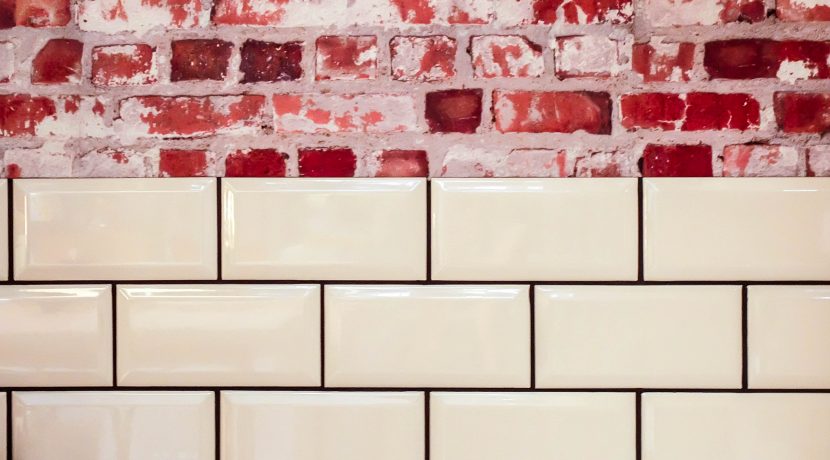Cleaning grout isn’t just about the type of tile cleaner you use; it’s also about the methods you employ for getting the stains out. The best way to lift the maximum amount of dirt and grime is to apply a solution and give it enough time to soak in and work, before scrubbing it off. Here is a step-by-step guide:
Use a dry broom or mop to wipe across the floor tiles, or a dry cloth to wipe wall tiles, before starting the grout cleaning process. This gets rid of any dust that’s accumulated, affording you better access to the grout.
Apply your chosen cleaning solution to the grout, ensuring all areas are well covered. You may find that you need to keep applying the solution regularly as it soaks in. You don’t want to saturate the floor, but you want to make sure the crevices are well covered.
Leave the tile cleaner for around 30 minutes – enough time to loosen the stains, making them easier to lift off.
Use a hard-bristled brush to scrub the grout clean. DIY stores sell dedicated grout brushes, but you may find that an old toothbrush works just as well – just remember not to use it in your mouth afterwards!
Rinse the floor or wall with clean water and dry. For stubborn stains, you may find you need to repeat the process on a regular basis to see optimal results.
Tile Cleaning Tips
When it comes to tile cleaning, it’s actually a very similar process. Stores sell specialized tile cleaner, but you can choose to make your own using bleach, or a similar thick paste of baking soda and water. If you’ve got marble tiles, however, it’s best to stick to a mild dishwashing soap, as acidic products – even things like vinegar – can cause damage. Apart from troublesome areas of caked-on food and dirt, you shouldn’t need to scrub as vigorously as when cleaning grout. A good quality cloth will usually suffice.
Cleaning Bathroom Tiles
Cleaning bathroom tiles can be frustrating, as it can seem that grout becomes discoloured almost as soon as it’s been cleaned. Bathroom tiles – especially wall tiles around a bath or shower cubicle – are also vulnerable to mould growth, which is particularly evident in white and other light coloured grouts. White vinegar is good for tackling mould, but its worthwhile looking for a tile cleaner with mould inhibitors that prevent any further growth. You’ll need to clean regularly for these inhibitors to work to the best of their ability.
Tile and Grout Cleaning Maintenance
Make sure you include tile and grout cleaning as part of your regular cleaning schedule to slow down the discolouration of grout. Try to vacuum tiled floors on a daily basis, and mop or wipe on a weekly basis. It’s also beneficial to use a steam cleaner on tiles periodically to minimize ground-in dirt. Be sure to clean up any spills as soon as possible, to prevent stains from adhering to the floor.
Clean tiles and grout improve the appearance of any kitchen or bathroom, making the room appear brighter, cleaner, and larger. Try these tips, and the results will speak for themselves.
What Tile Grout Cleaner Do I Need?
Choosing a tile grout cleaner depends on your preferences. Commercial products like Cif Power & Shine Bathroom will offer good results with very little effort, but if you’d prefer to use something homemade, there are options available. Just be sure never to mix different cleaning solutions, as some combinations (bleach and vinegar, for example) are toxic.
- Many different brands offer specialist grout cleaning solutions that are designed to bring back the brightness of your grout. When you’re looking at the different options, it’s best to choose one that has anti-fungal properties to help reduce the rate of mould growth – especially in the bathroom where warm, steamy environments encourage the spread of fungus.
- Some homeowners swear by bleach products for cleaning grout – and for white and light grey grouts, bleach can certainly be very effective. Oxygen bleach and chlorine bleach are particularly renowned for their tile and grout cleaning abilities, but they should be handled with care, and should never be used on black or other coloured grouts, as they might have a fading effect. Be sure to follow the directions on the label when using any cleaning product.
- If you’d prefer not to use bleach products for tile cleaning, why not try making your own natural tile cleaner? Grout responds very well to the cleaning powers of acids – such as those found in vinegar – and the whitening properties of baking soda. To make an effective tile grout cleaner, simply mix these two products until they form a thick paste that can be easily applied to the grout.
Copyright to the original publisher for Cleanipedia.
Sponsored by The econcierge Delivering the usual exceptionally. Get in touch with them at [email protected]

